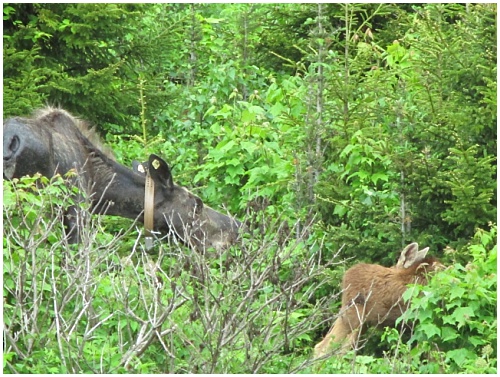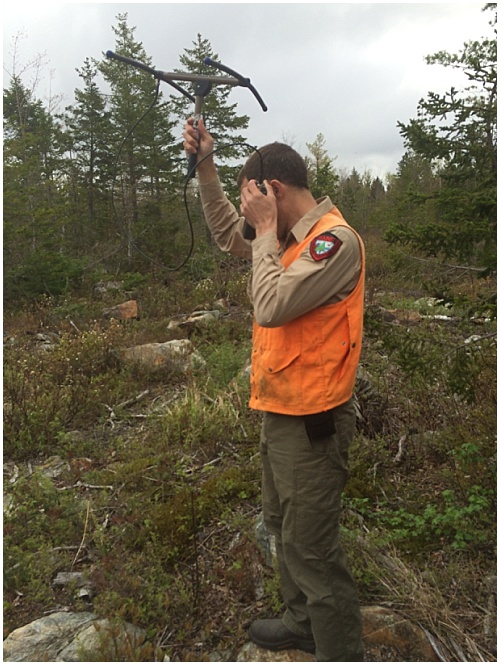May 27, 2020 at 3:16 pm
During calving season for moose, which runs from early May to early August when cows are weaning their calves onto a vegetarian and not solely milk-based diet, I have a group of spies in the woods. These spies (really, they are moose stalkers or seasonal wildlife technicians) spend 12 weeks sneaking up on GPS collared cows to determine whether they have a calf with them.

So how does this work? Twice a day (5am and 5pm) the GPS collars send out a physical location received by a satellite that biologists can download on a computer. In the morning the moose spies look where the moose is on a map and plot the best way to walk in on the moose and spy on her. While it sounds a little creepy it is an excellent way to determine if a cow has had a calf without putting an actual GPS collar on a newborn calf in May – which is intensive, expensive, and a bit intrusive.
Now for the gritty part. Sneaking up on a cow moose on high alert is not easy—hence we use highly trained operatives and equipment to give us an edge. Remember a cow has excellent hearing, an excellent sense of smell, and knows her home way better than any of us. And well, a cow moose is not exactly welcoming when she discovers you trying to sneak up on her and her calf!

The receiver and antenna we use (see photo above) can be “tuned” up and down with the unique radio frequency of the moose to estimate distance from that moose. So, as we walk closer to the moose, we can gauge how close that is as we increase or decrease the numbers on the receiver. The name of the game is to see her before she sees (hears/smells) us (and hopefully she never knows we are there)! We use the wind, topography, and slow movements to put the sneak on a moose! And even in the thick woods of Maine we use binoculars to see ahead the short distances we need to cover while stalking a moose to detect an ear flicking or movement or color that doesn’t quite fit in with the rest of the scenery.
When we get close enough based on the receiver and how far off her number or frequency we are, we stop and stand still painstakingly looking and listening to make sure we don’t bust her out of cover (this can be challenging at the height of black fly or mosquito season)! In the thick woods of Maine, we can easily be in sight and ear shot of her and not see her! Many times, we stand or crouch behind a tree and wait, and wait, and wait. And like a ghost suddenly she appears. We watch for movement. Sometimes the cow is bedding, sometimes she is feeding. If she has a calf it could be between her legs or behind her so that we must wait and watch patiently to detect the calf.
This secret spy stealth mission is repeated throughout the summer on close to 90 cows in western and northern Maine. Moose spies need to be 99% sure by the time the calf is weaned in summer that the cow has a calf at heel, never had a calf, or had a calf and lost it (mortality). This takes a lot of field time, patience, and dedication.
This information gives us insight on how many GPS collared cows had calves in a season as well as how many of those calves survived into August. By August calves are in good shape to make it into their first winter. The good news is although not as many cows give birth to calves as a few decades ago (that is a story for another blog), of the calves that are born in May, the majority survive to enter their first winter.
Over the course of the next year, Lee Kantar, Maine's moose biologist, will share a behind the scenes look at how the Department studies the iconic moose, from spying on cows in the summer and counting winter tick in the fall to collaring moose and conducting aerial surveys via helicopter in the winter and performing necropsies late winter/early spring. We hope you will follow along.
You can also learn more about moose and how winter ticks are impacting the population and what can be done at mefishwildlife.com/wintertick.